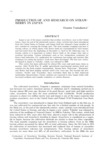Production of and Research on Strawberry in Japan
Tropical agriculture research series : proceedings of a symposium on tropical agriculture researches
| ISSN | 03889386 |
|---|---|
| 書誌レコードID(総合目録DB) | AA00870529 |

本文フルテキスト
tars23-_248-256.pdf1.55 MB
Japan is one of the major countries that produce strawberry, next to the United States. Since the end of the nineteenth century, many varieties have been introduced from the United States or Europe, and Japan itself has released a large number of new varieties by crossing the foreign ones. The most popular cropping type here is forcing culture, in which plants with flower buds are transplanted in vinyl houses and harvested from the beginning of December to April in the following year. In forcing culture it is important to induce flower buds at the proper time and to continue harvesting. Various techniques such as low temperature treatment for flower bud induction, CO2 application for continuous harvesting and nutrient film technique for easing the farmer's work have been developed. The first new variety developed in Japan is 'Fukuba', which was released in 1899.
This variety has been cultivated for almost fifty years and used many times as parents. After World War II, public agricultural experimental stations bred new varieties for the fresh market consumption. Among them 'Hokowase', 'Harunoka' and 'Reiko' had been leading varieties until a few years ago. But recently the new varieties, 'Nyoho' and 'Toyonoka', have overtaken them due to their improved marketable characteristics. Future varieties are expected to have larger fruits with increased earliness and complex resistance to various diseases.
This variety has been cultivated for almost fifty years and used many times as parents. After World War II, public agricultural experimental stations bred new varieties for the fresh market consumption. Among them 'Hokowase', 'Harunoka' and 'Reiko' had been leading varieties until a few years ago. But recently the new varieties, 'Nyoho' and 'Toyonoka', have overtaken them due to their improved marketable characteristics. Future varieties are expected to have larger fruits with increased earliness and complex resistance to various diseases.
| 刊行年月日 | |
|---|---|
| 作成者 | Osamu Yamakawa |
| 公開者 | Japan International Research Center for Agricultural Sciences |
| 巻 | 23 |
| 開始ページ | 248 |
| 終了ページ | 256 |
| 言語 | eng |
